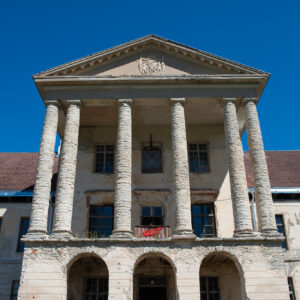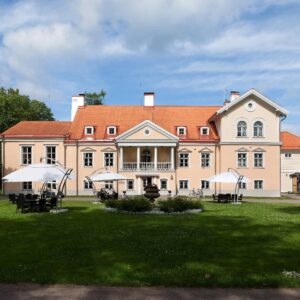The most remarkable architectural treasures of the history of Lahemaa can be found in Kolga, Palmse, Sagadi, and Vihula. Kolga manor, which belonged to the Stenbock family and is Estonia’s largest, still awaits a skilled restorer to restore it to its former glory. However, in Palmse, Sagadi, and Vihula, the manors are fully restored and waiting for visitors to explore. There, you can enjoy walks in well-maintained gardens and parks, as well as experience unique manor interiors.
The current buildings of Porkuni manor, which was originally constructed on the site of a fortress, date from the 19th century. The last lord of the manor, Rennenkampff, had a much grander building constructed on the estate between 1870 and 1874, which the locals came to call ‘Porkuni castle’. One corner of the building retains the helmeted hexagonal gate tower of the former fortress, which today houses the Porkuni slate museum. Structures made of slate in the manor complex include the main building, the carriage house, the stables, the granary, the vodka factory and a significant part of the garden wall. The manor today operates as a school and can only be viewed from the outside.
The girth of the stone is 10.2 m.
St. Lawrence used to be one of the most popular patron saints of the people.
Did you know...?
- You can take part in different events at the manor that are designed for children, history enthusiasts, adventurers, and romantics
- The manor is a popular venue for exhibitions, plays, and concerts and the perfect location for training events, conferences, weddings, and receptions
Ilumägi chapel was built by Palmse’s Baron Carl Magnus von der Pahlen between 1814 and 1843 on the site of a former wooden chapel. Its windows are adorned with stained glass produced by the Pahlens and wealthier farmers and officials from Palmse manor. In the cemetery you will see the handiwork of local smiths and stone hewers in its crosses. The fenced-off section of the cemetery holds the remains of the Pahlen family.
Kolga Manor is one of the largest and most historically important manor complexes in Estonia. It is located in the western part of Lahemaa National Park.
The main building exudes a sense of history. According to the first reports, the 13th-century Kolga Manor belonged to the Cistercian order. The manor's main building acquired its current appearance at the beginning of the 19th century, when the previous building was rebuilt into a classicist palace. Although some buildings have not yet been renovated, the manor complex still leaves a grand impression.
The manor is privately owned. You can visit the main building by appointment, during events, and on guided tours. Next to the manor house, you will find Kolga Museum.
Kuusalu Church, dedicated to protodeacon martyr St. Lawrence, is considered to be one of the oldest stone churches in Northern Estonia. It was most likely the Gotlandish Cistercian monks who started building a house of God on the boundary of their property next to the holy springs in Kuusalu at the end of the 13th century. By following their own traditions, of course.
In addition to the pulpit, altar, and clock tower, the older art heritage in St. Lawrence Church in Kuusalu also includes chandeliers, Eucharistic vessels made of tin, candle holders, and an embossed brass bracket from the 17th century. Other rarities include the portraits of Luther and Melanchthon as glass paintings.
Toolse Order Castle is one of the more recent medieval castles on the northern coast of Estonia. It is also a castle located closest to the sea. The initial fortified manor house was probably erected by the order in the 14th century with the purpose of protecting the port, trade location and routes. During the Livonian War, the castle passed on through many hands and finally ended up in the possession of the Swedish troops. It was entirely destroyed in the Great Northern War at the beginning of the 18th century.
Today inside the ruins: · Excursions are offered to provide insight into history · An exciting adventure path was created · A pirate ship · Treasure quests and games of skill are organised on advance notice
Vainupea Chapel was consecrated in the summer of 1893. However, the first written mention of the wooden beach chapel dates back to 1741. The construction of the present chapel was organised by Eduard von Dellingshausen, who was the squire of Aaspere and Sauste manors. The chapel was empty for years after the Second World War until Lääne-Viru Road Administration and Valentin Transtok launched restoration works in 1988. The restored chapel was re-consecrated in 1989. Today, the chapel is a popular venue for concerts and weddings.
Did you know that: - Estonian painter Richard Sagrits, who was born in Karepa near Vainupea, is buried in the nearby cemetery.



